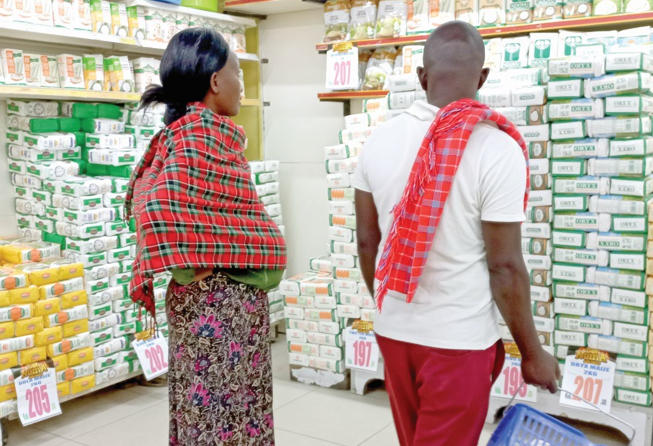Cheaper food prices to ease cost of living

With different parts of the country reporting that harvesting of maize has started in earnest, the cost of basic food items — notably maize flour, potatoes and vegetables has been declining, offering slight respite for Kenyans who have been feeling the acute pressure of inflation.
A highly placed government source told PD that this year, farmers had put over 250,000 acres under maize.
“We will get a bumper harvest,” the source said. “Not because productivity per acre has gone up but because the acreage under maize has increased significantly.”
According to him, decision by the government to subsidise the cost of fertilizer ahead of the long rains had made it possible for farmers — particularly in the North Rift and Narok regions — to put more land under the crop.
And earlier this week, the Cabinet sitting in Kakamega acknowledged the reduction in the cost of food.
“Relief in the household spend on food was attributed to crop maturity and harvests in the South Rift, Nyanza, Central, Eastern and Coast regions,” a dispatch from the Cabinet office on Tuesday stated.
To guard against post-harvest losses, which perennially undermine food security, the government has authorised the purchase of mobile dryers in addition to ordering the National Cereals and Produce Board (NCPB) to buy one million bags to revive the Strategic Food Reserve. The board is expected to set the minimum price per bag to cushion farmers from a glut in the grain market.
The new measures President William Ruto outlined during his tour of western Kenya, which ended yesterday, are also expected to inject new life in the sugar sector.
Already, the National Treasury has asked MPs to approve its proposal to pay off debts owed by sugar millers to the tune of Sh118 billion, a move that could pave the way for their revival and the subsequent improvement in earnings for farmers in that region.
Should the move bear fruit, it will lead to a reduction in sugar prices, which have exerted pressure on the food and beverages basket since January when the cost of a 1kg packet crossed the Sh240 threshold.
A source told PD this week that in the last three months, the agriculture sector has recorded robust growth, and this is expected to further reduce the cost of food and an increase in incomes for workers in the sector, which remains Kenya’s leading source of employment.
“The only challenge remains inflation caused by the adjustment in the Value Added Tax on fuel,” he said.
This is expected to exert pressure on the cost of both food and non-food items due to high transport costs.
In data released by the Kenya National Bureau of Statistics (KNBS) in July, the prices of food had decreased marginally by July largely due to a decline in the prices of groceries.
Multiple interviews
Multiple interviews with Kenyans from various parts of the country yesterday confirmed that whereas food prices were on the decline, the gains accrued in family budgets were being clawed back by high fuel prices.
In July, overall inflation rate slowed down to 7.3 per cent, which was within the government’s preferred range.
“This is expected to go below seven per cent going into September,” a source told PD.
The government targets to keep inflation between 2.5 and 7.5 per cent.
An increase in the number of tourists arriving in the country, coupled with the increasing dollar inflows sent by Kenyans in the Diaspora, are also expected to translate into a lower cost of living for more families, starting with those whose breadwinners work in the tourism sector and households with working adults abroad. In June, dollar inflows from Diaspora stood at Sh49 billion, according to data from the Central Bank of Kenya. Meanwhile, tourist arrivals increased from 88,654 in April to 96,245 in May, according to internet sources.
Over the last 15 months, the cost of living has been on a downward trajectory. In June, the price index of the food category decreased by 0.5 per cent, according to KNBS data.
“The prices of potatoes, tomatoes, cowpeas and cabbages declined by 12.2, 10.1, 8.3 and 8.1 per cent, respectively, between June 2023 and July 2023,” KNBS director general Macdonald Obudho said in his monthly inflation review report.
The KNBS data also showed that the reduced overall inflation rate eased because the cost of electricity and cooking gas eased slightly. Gas prices went down largely because VAT was reduced from 16 to eight per cent. On average, the prices of 200 kilowatts of electricity decreased by 4.4 per cent while 13kg cooking gas went down by 9.3 per cent to retail at Sh2,787 in July.
The cost of diesel has remained unchanged at Sh179.67 per litre since July 14 while the price for petrol rose to Sh194.68 for the same quantity. Kerosene is now Sh169.48 per litre.
The Central Bank disclosed in the latest report by its Monetary Policy Committee (MPC) that the tide of inflationary pressure was receding even further.
Notably, core inflation, a measure that excludes the erratic influences of food and fuel prices, witnessed a decline.
This measure is of particular significance as it provides insight into the secondary effects of inflation on various other goods and services.
In an encouraging shift, the overall inflation rate has made its way back within the confines of the government’s target range, aligning itself at 7.3 percent in July.
This range, spanning from 2.5 to 7.5 per cent, had been temporarily breached but has now been reestablished. However, it’s core inflation that has taken centre stage. This metric, which delves into the ripple effects of inflation, particularly emanating from the realms of food and fuel costs, has undergone a reduction from 4.1 per cent in June to a notable 3.8 per cent.
Centre stage
In light of these developments, the MPC arrived at a resolute decision that maintaining the current monetary policy stance was the appropriate course of action for the present circumstances. This decision takes into account the prevailing inflation dynamics and the committee’s anticipation of future trends, including a potential decrease in the inflation attributed to food prices.
The MPC provided a comprehensive statement to underline its decision. It highlighted that inflation has already nestled itself within the stipulated target range and further pointed out that the anticipated decline in food-related inflation is likely to bolster this trend.
Further, the committee underscored the alleviation of inflationary pressures arising from non-food and non-fuel sectors, which played a role in shaping their stance.
The challenge that the country has been facing, and which continues to impact on the cost of living is the depreciation of the shilling. Indicative rates published by CBK yesterday show that the currency was trading at an average of Sh145.4 to the dollar at the close of markets on Wednesday.











